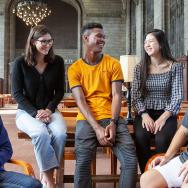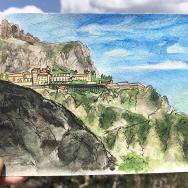Objects of study can take many forms: a slide of cells, a gallery of paintings, a stack of books from the library 20 volumes deep. Through work with faculty research mentors, University of Chicago students in the undergraduate College hone their research skills and contribute to the knowledge-making enterprise, all while exploring their own intellectual curiosities.
And at UChicago, almost any subject, text or artifact can be a springboard for those curiosities. Often, students take inspiration from professors in the distinctive Core curriculum, finding opportunities to explore a lifelong passion or even discover a new one.
“Undergraduates at the University of Chicago benefit from its institutional commitment to research; students have the opportunity to apply their learning in the research context alongside faculty mentors who are shaping and defining their fields,” said Nichole Fazio, executive director of UChicago’s College Center for Research and Fellowships, which supports students in their scholarly pursuits. “Undergraduate research has the potential to transform a student’s educational experience: inviting them to engage more deeply with their chosen discipline, help them build meaningful relationships with faculty and learn vital skills they can carry with them into their postgraduate experiences.”
What follows are the transformative experiences of four undergraduates deeply invested in research:
Studying the diverse materials of nature
For fourth-year Nivedina Sarma, the best thing about being a student researcher is the vast—and at times overwhelming—amount of skills to learn.
“I really like the feeling of being on a learning curve,” said Sarma, a chemistry major. “Month to month, I realize that I used to feel so uncertain about doing certain procedures, and now I can come in and do them on the weekend by myself. You have a really tangible way of measuring how much you’re learning.”
Opportunities for rapid learning are available to students as early as their first year. Sarma began her first research position after being inspired by Bozhi Tian, associate professor of chemistry.
“Prof. Tian had this really contagious enthusiasm about materials science, which I didn’t know much about at the time,” Sarma said. “But I thought, ‘He would be a good person to work for, because I would like to be that excited about what I’m doing.’”
In the Tian lab, Sarma assisted with research on the ways materials interface with biological systems for use in biomedical engineering. The lab explored the use of silicon nanowires to pace heart cells and create a tissue scaffold to drive regeneration of heart tissue.
Now she is furthering her knowledge in Prof. Dmitri Talapin’s materials science lab.
“Ultimately, I want to design biologically inspired materials,” Sarma said of her future goals. “I would like to be able to study all these different materials that nature has, and then be able to apply them to larger problems like climate change and energy conservation.”
A passion for art conservation
Passionate about art conservation, third-year Caroline Longo turned her attention to two pieces of public art on UChicago’s campus for her research: John Henry’s Forecast and Jene Highstein’s Black Sphere. Supported by the Smart Museum of Art, Longo served as an undergraduate research associate in artist intent and materials conservation. There, she explored methods for treating the two outdoor sculptures.
Situated outside of Court Theatre, Henry’s Forecast is made of painted aluminum and sits on a flowerbed, a position that contributes to its deterioration.
With guidance from the Anna Weiss-Pfau, the Smart Museum’s conservation manager, Longo reached out to Henry to seek his opinions on conservation of the sculpture. “I’ve been engaged in an ongoing dialogue with the artist and his daughter to determine the best route of treatment and accepted alternative display options that can preserve the longevity of the work.”
Using her background in chemistry, Longo investigated alternative materials for Black Sphere. Now in storage, the large concrete sculpture was formerly located on Ellis Avenue in front of the Surgery Brain Research Pavilion. Though currently painted to achieve its black color, the sculpture was originally made of black-pigmented concrete. After conducting a literature review on the artist’s practice, Longo created black-pigmented mockups of the piece. With the aid of instruments from the Pritzker School of Molecular Engineering at UChicago, Longo conducted a scientific analysis to assess the viability of each material for an installation such as this, determining that the black-pigmented concrete is has a richer, more durable color but can require highly specific environmental conditions for a stable pour.
Since completing this project, Longo has interned at the Solomon R. Guggenheim Museum in New York, further affirming her interest in contemporary art conservation.
“Conservation is so much more than conducting treatments,” Longo said. “A great deal of interdisciplinary research goes into determining the best treatment or exhibition plans for a work of art. My conservation research with the Smart has given me key skills needed to think critically about questions in the conservation field and has been a crucial stepping stone in my career.”
An eye for biological psychology
For third-year Joe Henry, undergraduate research is an opportunity to explore his interdisciplinary interests of psychology, biology and computer science. He works in Prof. Dario Maestripieri’s behavioral biology lab, where he assists with research about the evolutionary origins of human and primate behavior. His main project explores social relationships and how humans respond to violent imagery.
“We used eye-tracking software to investigate how people gather social information from violent images,” Henry said. “The first time the data was analyzed, we found that people primarily look at human faces in the images until the scenes become violent. My job was to determine that this was not simply a matter of physical saliency, meaning that people looked at the objects and contact points because they are socially significant information points and not just particularly eye-grabbing.”
Initially, Henry majored in psychology to gain insight into humanity that could be broadly applied to many fields or careers. “It wasn’t until I took biological psychology that I was really inspired by research. During this class, I saw research as active contribution to the betterment of human society.”
While Henry intends to become a psychiatrist one day, he plans to focus on research before enrolling in medical school and sustain that passion for research throughout his career.
“When a researcher asks a question, they are attempting to unravel a mystery,” he said. “When that mystery has to do with why we think and behave the way we do, it feels to me like you are poking at the very questions of our existence. It is quite invigorating to consider a job that is aimed at answering these larger questions.”
Spanning the humanities and Germanic studies
Fourth-year Serena Strecker spent the summer in Wittenberg, Germany, researching figurative language in Martin Luther’s printed sermons for her B.A. thesis. But Strecker previously built her skills through a research position with Assoc. Prof. Ada Palmer in the Department of History.
Majoring in interdisciplinary studies in the humanities and Germanic studies, Strecker has a passion for close reading and primary source research. Her research position gave her the opportunity to work closely with Palmer on her ongoing cross-cultural research on censorship. While Strecker studied German censorship, she collaborated with a team of undergraduates specializing in other language groups.
“Censorship is an important issue in all periods and regions of the Earth, so it was a perfect opportunity to try out a new model of student work: organizing a team of undergraduates around a single research question, each pursuing independent work in a different region and time period,” Palmer said. “It's wonderful finding a model in which students’ excitement about one another’s discoveries prompted them to so much energy and productivity.”
Strecker relishes the creative inquiry that goes into presenting humanities research in the most compelling way. “I’ll go to the Reg and check out a bunch of books—sometimes 20 at once. Then I’ll check out which have the most interesting bibliographies and seem most well-researched,” Strecker said.
Since working with Palmer, Strecker also has begun a position with Prof. Christopher Wild in the Department of Germanic studies, which goes hand-in-hand with her work on printed sermons for her B.A. thesis. These experiences have provided her a foundation for pursuing graduate study and ultimately, a career in academia.
“Getting to talk about these things all the time, and getting to work with the old texts and see how they can speak to you in new ways, is really exciting,” she said.

